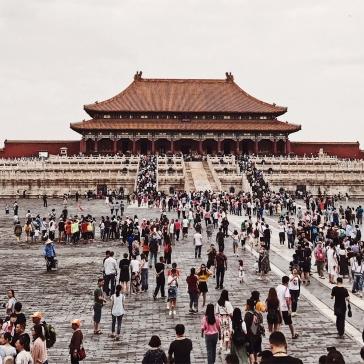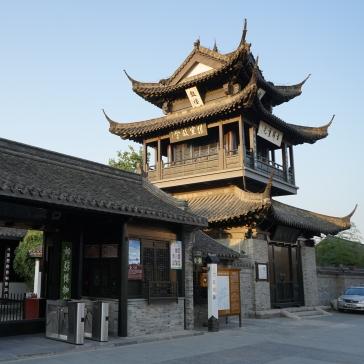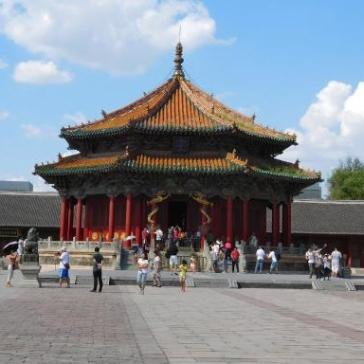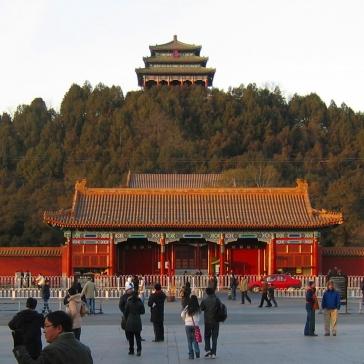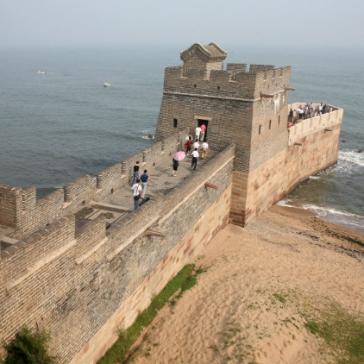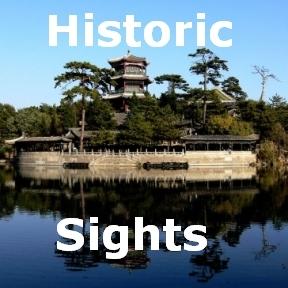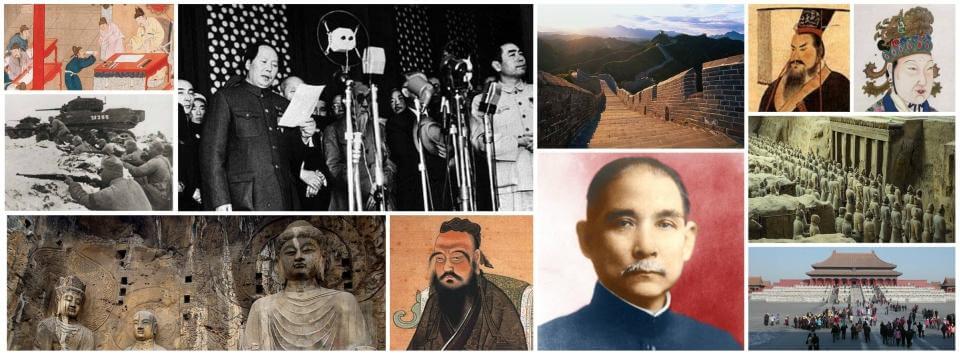
Ming Dynasty (AD 1368 - 1644)
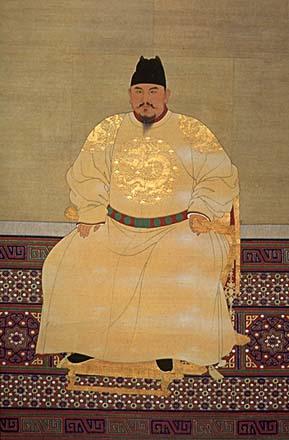 the Hongwu Emperor, founder of the Ming dynastyAfter proclaiming the Ming dynasty, the Hongwu Emperor Zhu Yuanzhang left his 4th son Zhu Di (AD 1360 - 1424) in control of Dadu (Beijing) in order to use it as a military outpost that could ward off a possibly returning Mongol army. The new Ming capital was established at Nanjing (Chinese for southern capital) and thereby closer to Zhu Yuanzhang's southern power base.
the Hongwu Emperor, founder of the Ming dynastyAfter proclaiming the Ming dynasty, the Hongwu Emperor Zhu Yuanzhang left his 4th son Zhu Di (AD 1360 - 1424) in control of Dadu (Beijing) in order to use it as a military outpost that could ward off a possibly returning Mongol army. The new Ming capital was established at Nanjing (Chinese for southern capital) and thereby closer to Zhu Yuanzhang's southern power base.
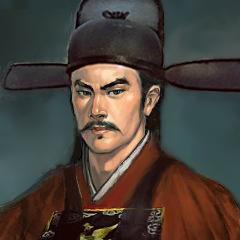 painting of the Hongwu Emperor's chief minister Hu WeiyongAfter further military campaigns that successfully consolidated his control over all of China, Zhu Yuanzhang set about rebuilding a proper Confucian institutional bureaucracy within his lands that was staffed by the Chinese literati elite once again. However, Zhu Yuanzhang never fully trusted the literati class, possibly because of their improper selfish behaviour during the plague outbreak in the late 1340s and early 1350s or because of his own lack of a proper education.
painting of the Hongwu Emperor's chief minister Hu WeiyongAfter further military campaigns that successfully consolidated his control over all of China, Zhu Yuanzhang set about rebuilding a proper Confucian institutional bureaucracy within his lands that was staffed by the Chinese literati elite once again. However, Zhu Yuanzhang never fully trusted the literati class, possibly because of their improper selfish behaviour during the plague outbreak in the late 1340s and early 1350s or because of his own lack of a proper education.
His mistrust of the literati expressed itself in his decision to immediately suspend the imperial examinations (that he had reinstated himself) just after they were first held again in AD 1370. Realizing later that he needed the literati to effectively govern China, he reinstated the examination system in AD 1380. The imperial examinations henceforth continued without further interruption until 1905.
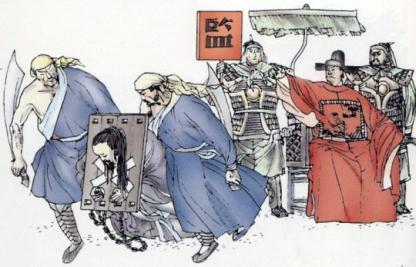 drawing of Hu Weiyong's executionZhu Yuanzhang's suspicion of the literati also expressed itself in repeated bloody purges, most notably in AD 1380, when he became suspicious of the loyalty of his chief minister Hu Weiyong and had him, his family, everyone who worked with him and their families executed, altogether thousands of people! He subsequently abolished the office of chief minister and took its administrative and political functions into his own hands as well, leaving him little time for rest and sleep.
drawing of Hu Weiyong's executionZhu Yuanzhang's suspicion of the literati also expressed itself in repeated bloody purges, most notably in AD 1380, when he became suspicious of the loyalty of his chief minister Hu Weiyong and had him, his family, everyone who worked with him and their families executed, altogether thousands of people! He subsequently abolished the office of chief minister and took its administrative and political functions into his own hands as well, leaving him little time for rest and sleep.
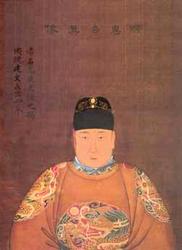 Ming dynasty picture of the Jianwen EmperorAfter Zhu Yuanzhang's death in AD 1398 and according to his wishes, his grandson Zhu Yunwen (AD 1377 - 1402) succeeded him on the throne. The normal custom at that time in history was to pass on the throne to the oldest surviving son. That however was Zhu Di, Zhu Yuanzhang's 4th son, who understandably resented his father's decision.
Ming dynasty picture of the Jianwen EmperorAfter Zhu Yuanzhang's death in AD 1398 and according to his wishes, his grandson Zhu Yunwen (AD 1377 - 1402) succeeded him on the throne. The normal custom at that time in history was to pass on the throne to the oldest surviving son. That however was Zhu Di, Zhu Yuanzhang's 4th son, who understandably resented his father's decision.
Zhu Yunwen was a well-educated young man who had grown up within the imperial palace, where many Confucian officials had tutored him. That's why he had a totally different approach of dealing with the literati. He chose the reign title of Jianwen Emperor for himself (jianwen = to nourish the cultural, literary), which signalled that he planned to have a much more productive and trusting working relationship with the literati officials.
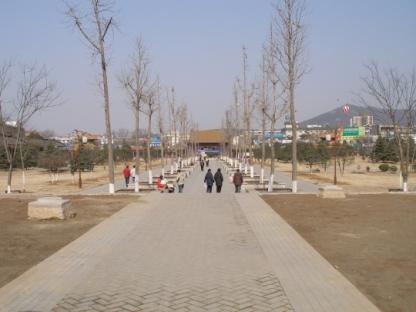 site of the former Ming dynasty imperial palace in NanjingZhu Di saw this as a betrayal of the political ideals of his father Zhu Yuanzhang and began to plot to usurp the imperial throne by himself. Between AD 1400 and 1402, he undertook a series of political and military actions that culminated in his army's attack of the imperial capital Nanjing in AD 1402 in which the imperial palace was burnt down. The body of the Jianwen Emperor was never found,which led to speculation later on in history.
site of the former Ming dynasty imperial palace in NanjingZhu Di saw this as a betrayal of the political ideals of his father Zhu Yuanzhang and began to plot to usurp the imperial throne by himself. Between AD 1400 and 1402, he undertook a series of political and military actions that culminated in his army's attack of the imperial capital Nanjing in AD 1402 in which the imperial palace was burnt down. The body of the Jianwen Emperor was never found,which led to speculation later on in history.
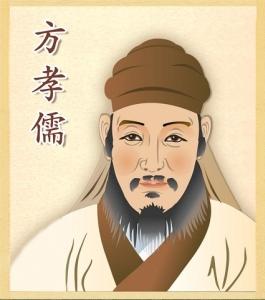 the official Fang Xiaoru who refused to accept Zhu Di as the new emperorThrough this attack, Zhu Di successfully usurped the imperial throne and proclaimed himself as the 2nd Ming emperor, erasing the short reign of the Jianwen Emperor from the official history books for some time.
the official Fang Xiaoru who refused to accept Zhu Di as the new emperorThrough this attack, Zhu Di successfully usurped the imperial throne and proclaimed himself as the 2nd Ming emperor, erasing the short reign of the Jianwen Emperor from the official history books for some time.
However, many Confucian literati officials at first refused to recognize Zhu Di as the legitimate new emperor. When the official Fang Xiaoru refused to acknowledge Zhu Di's legitimacy as emperor in an official edict, he and many of his sympathizers were executed.
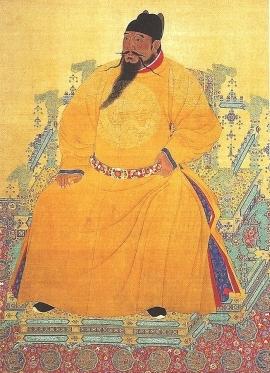 portrait painting by an anonymous court artist of Zhu Di, the Yongle EmperorThe remaining literati officials then accepted the legitimacy of Zhu Di's ascent to power. Zhu Di reigned under the title of Yongle Emperor (yongle = eternal happiness or eternal joy or everlasting happiness) and his working relationship with the literati officials was henceforth fairly positive. Unlike his father before him, he didn't even have to resort to occasional bloody purges to keep them under control.
portrait painting by an anonymous court artist of Zhu Di, the Yongle EmperorThe remaining literati officials then accepted the legitimacy of Zhu Di's ascent to power. Zhu Di reigned under the title of Yongle Emperor (yongle = eternal happiness or eternal joy or everlasting happiness) and his working relationship with the literati officials was henceforth fairly positive. Unlike his father before him, he didn't even have to resort to occasional bloody purges to keep them under control.
Most notably, Zhu Di increased the political and administrative power of the Grand Secretariat. That was the policy-formulating and document-processing institution of the imperial government. As such, it was responsible for edicts, proclamations, allocation of funds, incoming reports from province-based officials or capital-based government ministries. Zhu Di henceforth employed its leading officials as his official counsellors and advisors.
In AD 1420, the Yongle Emperor Zhu Di moved the imperial capital and administrative center from Nanjing (henceforth a subsidiary political center) to Beijing ("northerly capital" in Chinese), a move that had taken a considerable amount of preparation time.
Upon Zhu Di's initiative, around 100,000 families of carpenters, stone masons, artisans etc. had moved north in AD 1407 in order to build a new great capital a few kilometres south of the Mongol capital of Dadu.
The result of these gargantuan building efforts - Beijing's Forbidden City - is now Beijing's most visited tourist attraction with millions of visitors per year.
 Panoramic photo of Beijing's Forbidden City
Panoramic photo of Beijing's Forbidden City
Forbidden City
Beijing's Forbidden City was the official residence for 14 emperors of the Ming dynasty and 10 emperors of the Qing dynasty from 1420 until 1912. It is the world's largest palace complex and one of the most visited tourist sights in the world with annual visitor numbers approaching 20 million. Most Chinese people nowadays refer to this UNESCO world heritage site as Gugong (former palace) whereas in English it is also referred to as the Palace Museum.
Click here to learn more!Opening Hours
April - October: 8.30am - 5pm
November - March: 8.30am - 4.30pm
The Forbidden City is closed on Mondays (except during Chinese holidays).
Entrance Ticket Prices
April - October: 60 yuan
November - March: 40 yuan
Treasure Gallery: + 10 yuan
Clock and Watch Gallery: + 10 yuan
Tickets only available up to 1 hour before closing time!
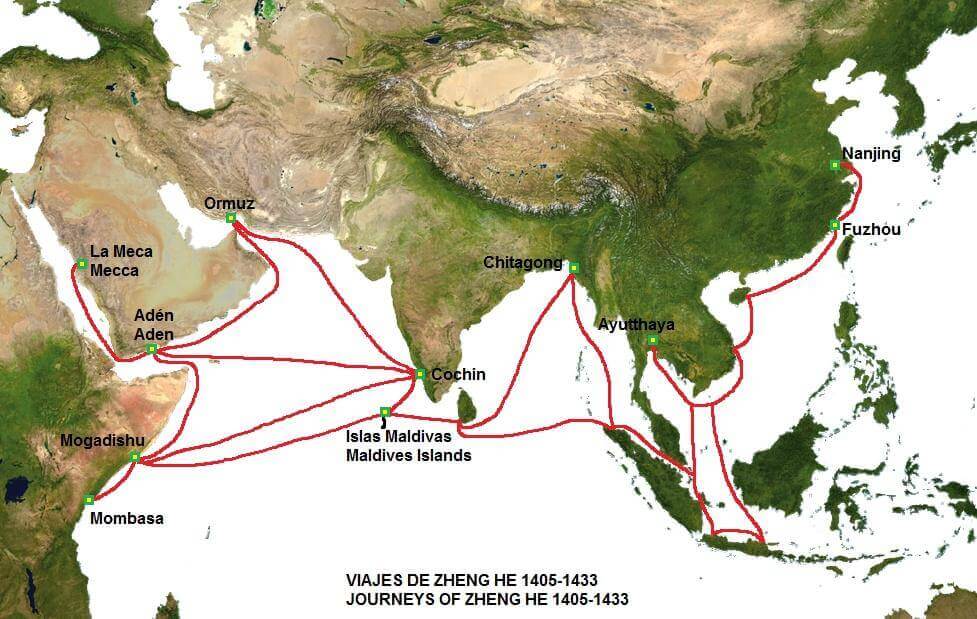 Map of the exploratory sea voyages of Admiral Zheng He between AD 1405 - 1433
Map of the exploratory sea voyages of Admiral Zheng He between AD 1405 - 1433
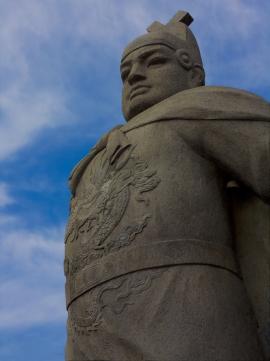 monument of the Admiral Zheng He (located outside the Stadthuys in Malacca, Malaysia)The Yongle Emperor also demonstrated his power and the wealth of China by sending the eunuch Zheng He (AD 1371 - 1433) as commanding admiral of a grand maritime fleet of hundreds of ships on seven exploratory voyages all around Southeast Asia, the Indian Ocean, the east coast of Africa and the Persian Gulf. Before Zheng He, only Chinese maritime traders had been active in these waters.
monument of the Admiral Zheng He (located outside the Stadthuys in Malacca, Malaysia)The Yongle Emperor also demonstrated his power and the wealth of China by sending the eunuch Zheng He (AD 1371 - 1433) as commanding admiral of a grand maritime fleet of hundreds of ships on seven exploratory voyages all around Southeast Asia, the Indian Ocean, the east coast of Africa and the Persian Gulf. Before Zheng He, only Chinese maritime traders had been active in these waters.
These voyages, that took place between AD 1405 and 1433 (continuing even after the Yongle Emperor's death in AD 1424), projected China's power into the world and led to greater diplomatic and trade relations between China and the visited countries. After AD 1433, the Chinese imperial state readjusted its focus from maritime exploration back to the traditional strategic concern of protecting its internal borders (especially its inner-Asian frontier) from potentially dangerous outside forces.
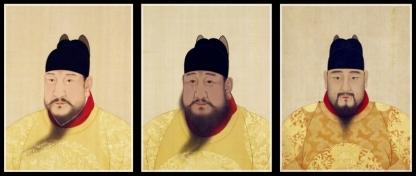 Ming dynasty paintings of the Left: Hongxi Emperor, Zhu Gaochi Middle: Xuanzong Emperor, Zhu Zhanji Right: Yingzong Emperor, Zhu QizhenAfter the Yongle Emperor's death in AD 1424, several young emperors succeeded him on the Ming throne who didn't contribute much leadership.
Ming dynasty paintings of the Left: Hongxi Emperor, Zhu Gaochi Middle: Xuanzong Emperor, Zhu Zhanji Right: Yingzong Emperor, Zhu QizhenAfter the Yongle Emperor's death in AD 1424, several young emperors succeeded him on the Ming throne who didn't contribute much leadership.
The first of those was the Yongle Emperor's son Zhu Gaochi (AD 1378 - 1425) who reigned for less than a year. The next young emperor then was Zhu Zhanji (AD 1399 - 1435). He reigned for about a decade from AD 1426 - 1435. His successor Zhu Qizhen (AD 1427 - 1464) was only an 8-year-old boy when he ascended the throne in AD 1435.
Despite weak leadership from the part of the emperor during the first part of the 15th century, the Ming dynasty finally stabilized by the middle of the 15th century and entered a Golden Age of peace and prosperity through great domestic economic expansion.
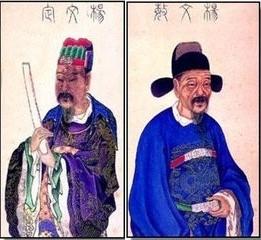 Left: Grand Secretary Yang Pu Right: Grand Secretary Yang RongThe institution of the Grand Secretariat had become a very powerful political force in China during the period of weak leadership. Among its many Confucian officials, the three Grand Secretaries Yang Shiqi (who was also a prominent literary authority), Yang Rong and Yang Pu - now known as "The Three Yangs" - gained special distinction for their guidance of the affairs of China until the early 1440s.
Left: Grand Secretary Yang Pu Right: Grand Secretary Yang RongThe institution of the Grand Secretariat had become a very powerful political force in China during the period of weak leadership. Among its many Confucian officials, the three Grand Secretaries Yang Shiqi (who was also a prominent literary authority), Yang Rong and Yang Pu - now known as "The Three Yangs" - gained special distinction for their guidance of the affairs of China until the early 1440s.
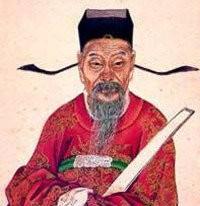 Grand Secretary Yang ShiqiWhereas eunuchs had played a prominent role in the leadership of China during earlier dynasties, they were now relegated to clerical functions regarding imperial communications. In fact, the first Ming emperor Zhu Yuanzhang had even excluded eunuchs from any meddling in government affairs whatsoever. During his reign, they were not allowed to work with official government documents and weren't even allowed to be taught to read!
Grand Secretary Yang ShiqiWhereas eunuchs had played a prominent role in the leadership of China during earlier dynasties, they were now relegated to clerical functions regarding imperial communications. In fact, the first Ming emperor Zhu Yuanzhang had even excluded eunuchs from any meddling in government affairs whatsoever. During his reign, they were not allowed to work with official government documents and weren't even allowed to be taught to read!
Zhu Yuanzhang's son Zhu Di had however used eunuchs as emissaries and secret agents before usurping the throne with his attack of Nanjing. Later as an emperor, he had continued to use eunuchs as his personal agents, perhaps because of his mistrust of the literati.
During Zhu Di's reign, eunuchs got involved in the transmission and handling of official documents within the imperial palace. A special academy inside the imperial palace trained them for this task.
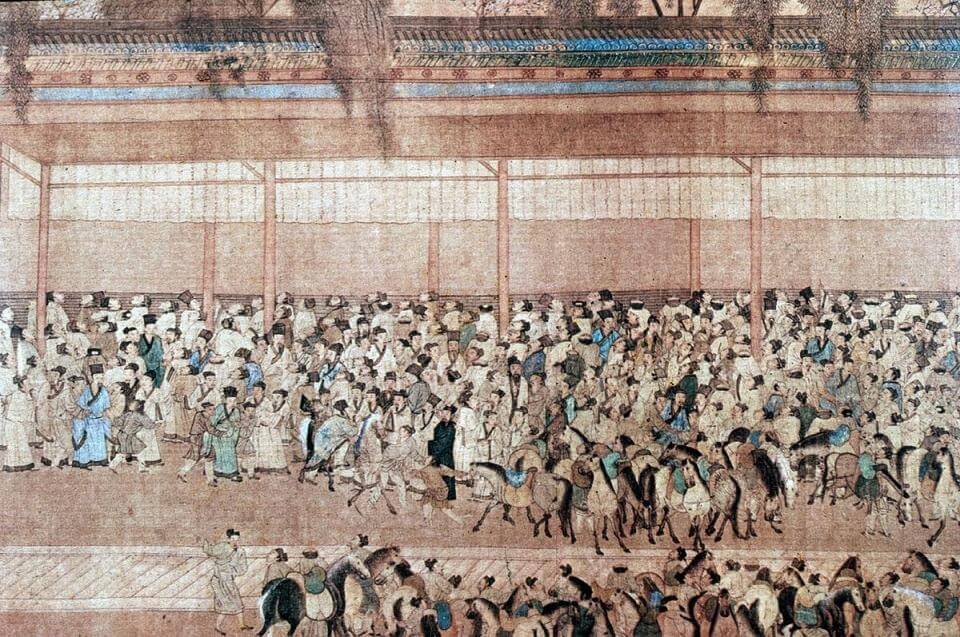 painting (ca. AD 1540) by Qiu Ying showing imperial examination takers gather around the wall where results had been posted
painting (ca. AD 1540) by Qiu Ying showing imperial examination takers gather around the wall where results had been posted
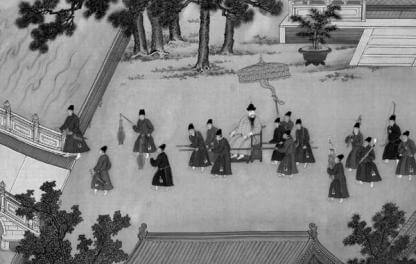 Ming Emperor Xuanzong with his imperial eunuchsMeanwhile, the Confucian literati officials continued with their traditional tasks of administering the country from the outside of the inner palace and all around the country, maintaining the imperial examination system and shaping the cultural discourse within the empire.
Ming Emperor Xuanzong with his imperial eunuchsMeanwhile, the Confucian literati officials continued with their traditional tasks of administering the country from the outside of the inner palace and all around the country, maintaining the imperial examination system and shaping the cultural discourse within the empire.
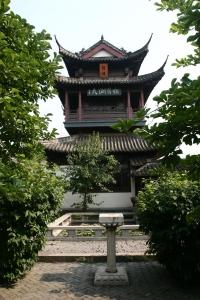 inside the Yucheng Post in GaoyouThe power balance between influential eunuchs within the inner palace and the literati officials outside of it was fairly stable during this period of the Ming dynasty.
inside the Yucheng Post in GaoyouThe power balance between influential eunuchs within the inner palace and the literati officials outside of it was fairly stable during this period of the Ming dynasty.
The Ming dynasty eunuchs gained more and more political power over time, especially within the secret police and as special commissioners that were sent out by the emperor to oversee certain economic activities. Outside the compounds of the imperial inner palace, eunuchs had to deal with the Confucian prejudice that it is sinful to cripple one's body and cut off one's bloodline. A number of powerful eunuchs that could afford it sought to gain some respect within society by patronizing Buddhism and the arts.
Economically, this period of the Ming dynasty was a great age of economic development. That was facilitated to a large degree by the network of postal roads that spanned all across the Ming empire.
The first Ming emperor Zhu Yuanzhang had initiated the construction of these postal roads. By the middle of the 15th century, there were postal stations every few miles. At these places, postal couriers could rest overnight or simply just exchange their tired horses with fresh ones. Some of these postal stations, where messengers and traveling officials rested in the historic past, have in modern times developed into urban centers such as the city of Zhumadian in Henan province. This can often already be seen in the Chinese names of these places. The city name Zhumadian for example literally means "a place where people rest themselves and their horses."
The perhaps greatest example for such a postal station that is still intact and well-preserved in China today is the Yucheng Post in Gaoyou (north of Yangzhou) that makes for an interesting visit.
Yucheng Post
The Yucheng Postal Stop in Gaoyou (Jiangsu province) is the largest and best-preserved ancient postal station in all of China. Also known as Yucheng Post or Mengcheng Post, it was built near the Grand Canal in AD 1375 during the time of the Ming dynasty. When it was still in operation, it was a rest stop (and a place to change horses) for the empire's official postal carriers. It is now open to the public as the Museum of Chinese Postal History.
Click here to learn more!Opening Hours
8.30am - 5.30pm
Entrance Ticket Prices
20 yuan
15 yuan for students
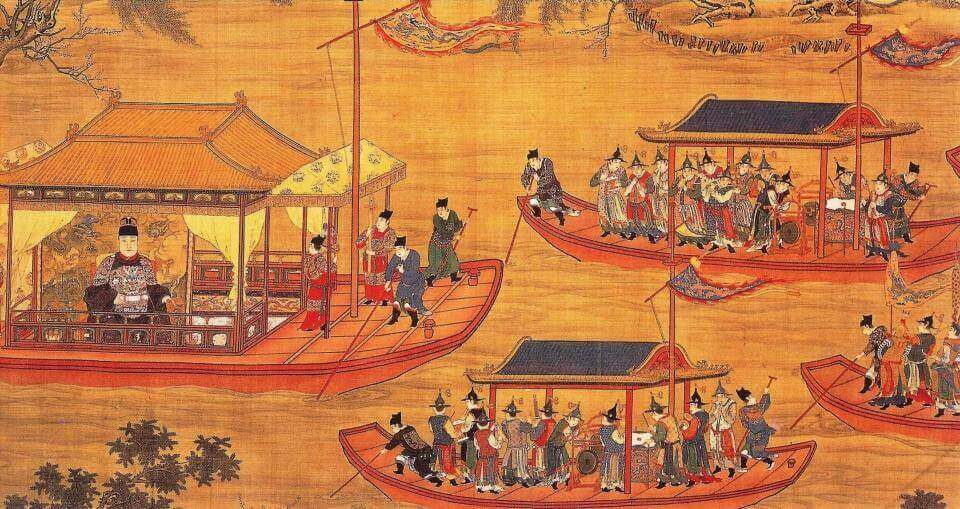 Ming court artist painting showing the Ming emperor Jiajing on his state barge
Ming court artist painting showing the Ming emperor Jiajing on his state barge
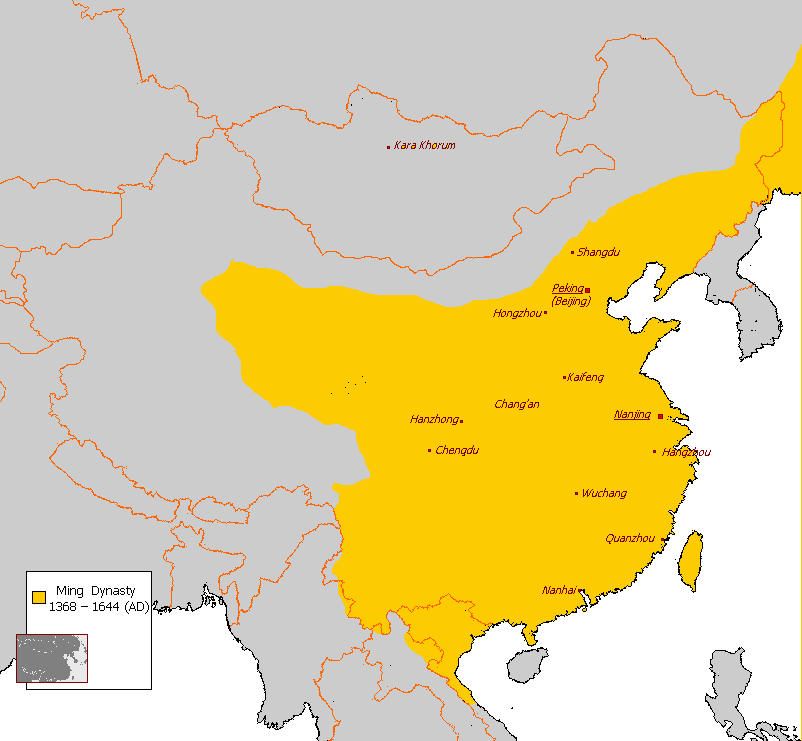 Map of the Ming dynasty stateIn this way, it took a mere five weeks to reach the southern parts of the empire from Beijing. Postal couriers transmitted official messages all across the empire, keeping the emperor and government officials everywhere well-informed of all the latest developments across the country.
Map of the Ming dynasty stateIn this way, it took a mere five weeks to reach the southern parts of the empire from Beijing. Postal couriers transmitted official messages all across the empire, keeping the emperor and government officials everywhere well-informed of all the latest developments across the country.
This network of postal roads was also used by merchants and other travellers. Everyone who used these roads benefited from the fact that guards were posted along these routes and that the army was garrisoned nearby. In this way, it was safe for merchants who carried valuable trade goods or wealthy travellers to travel along these roads. Since private travellers and merchants weren't allowed to stay at the official postal stations, their needs for lodging and food were met by private hostels, taverns and inns that began to spring up along these routes.
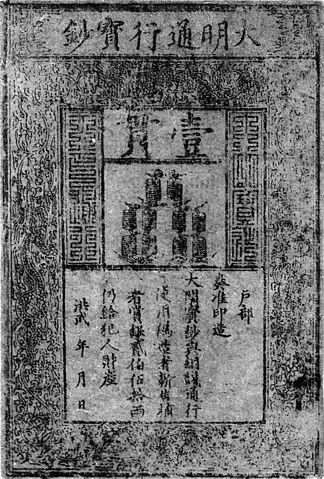 Ming dynasty banknoteEven though they couldn't stay at the official postal stations, private merchants were however allowed to use the imperial transport barges (if they weren't fully loaded already) for the shipment of their commercial goods along the Grand Canal. This canal had specifically been built to ship grain from southeastern China to Beijing (where not enough grain could be grown to feed its large population). Since the earlier mentioned process of regional economic specialization had continued and even intensified (the Jiangnan region specialized in cotton and silk production, certain areas in Zhejiang and Hunan became tea growing regions, Jingdezhen in northern Jiangxi produced porcelain at its imperial kilns etc.), there were more and more products that were traded all over China and even internationally. Not only commercial goods were transported along the imperial postal roads, but also large amounts of food, since the highly specialized economic centers had become food-importing regions.
Ming dynasty banknoteEven though they couldn't stay at the official postal stations, private merchants were however allowed to use the imperial transport barges (if they weren't fully loaded already) for the shipment of their commercial goods along the Grand Canal. This canal had specifically been built to ship grain from southeastern China to Beijing (where not enough grain could be grown to feed its large population). Since the earlier mentioned process of regional economic specialization had continued and even intensified (the Jiangnan region specialized in cotton and silk production, certain areas in Zhejiang and Hunan became tea growing regions, Jingdezhen in northern Jiangxi produced porcelain at its imperial kilns etc.), there were more and more products that were traded all over China and even internationally. Not only commercial goods were transported along the imperial postal roads, but also large amounts of food, since the highly specialized economic centers had become food-importing regions.
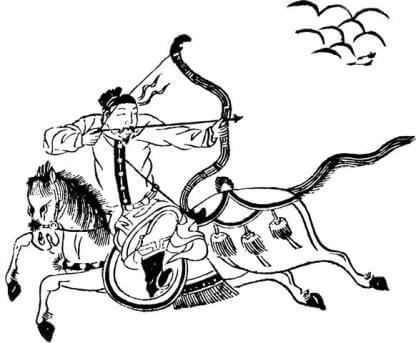 mounted archer of the Ming Dynasty armyIt was not only the improved logistics that had led to this expansion of trade, but also the increased money flows within China and internationally along with the emergence of prototypes of commercial banks. Paper money was used again during the Ming dynasty, bills of trade were used between merchants along with other kinds of private commercial paper, but it was especially the inflow of large amounts of silver (acquired in the tally trade from Japan's proliferating silver mines and from trading with the Spanish, who had established a trading post in Manila on the Philippines in the 1570s) that kept the Chinese domestic economy awash in cash and minimized the importance of barter.
mounted archer of the Ming Dynasty armyIt was not only the improved logistics that had led to this expansion of trade, but also the increased money flows within China and internationally along with the emergence of prototypes of commercial banks. Paper money was used again during the Ming dynasty, bills of trade were used between merchants along with other kinds of private commercial paper, but it was especially the inflow of large amounts of silver (acquired in the tally trade from Japan's proliferating silver mines and from trading with the Spanish, who had established a trading post in Manila on the Philippines in the 1570s) that kept the Chinese domestic economy awash in cash and minimized the importance of barter.
This monetization of the Chinese economy along with an increased international demand for Chinese goods further fired up the growth of the Chinese economy.
Despite the obvious benefits that the growth of international trade brought to China, the imperial government never adopted a laissez-faire approach but instead opted to keep it under tight control. Worried about coastal security, the first Ming emperor Zhu Yuanzhang had issued a maritime interdict in an effort to control the proliferating coastal trade. Occasionally, international trade was even completely banned. At these times, it was pirates - the chronic scourge of the southeastern Chinese coast in the 15th and 16th century - who stepped into the void and filled the demand for Chinese and international goods.
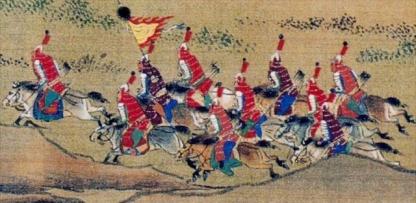 Ming cavalry shown in a scroll paintingThe significant accumulation of wealth along with higher agricultural yields (through technological improvements) during this Golden Age of the Ming greatly improved the standards of living of many if not most Chinese people and resulted in a substantial growth of the Chinese population from about 155 million people in AD 1380 to about 230 million people around AD 1500. By the late middle of the 17th century, the Chinese population had reached about 270 million people!
Ming cavalry shown in a scroll paintingThe significant accumulation of wealth along with higher agricultural yields (through technological improvements) during this Golden Age of the Ming greatly improved the standards of living of many if not most Chinese people and resulted in a substantial growth of the Chinese population from about 155 million people in AD 1380 to about 230 million people around AD 1500. By the late middle of the 17th century, the Chinese population had reached about 270 million people!
However, even this Golden Age of the Ming was not without its problems. Security issues along its northern frontier (recurring Mongol raids) and southeastern coast (pirate raids) led to factional division and political debates within the imperial court. In AD 1449, recurring Mongol raids along the Great Wall near the imperial capital of Beijing motivated the Emperor Zhu Qizhen upon the advice of his eunuch counsellor Wang Zhen (the Grand Secretariat had by then lost some of its influence after the period of "The Three Yangs") to launch a punitive military expedition against the Mongols, which he led by himself. That turned out to be disastrous when the Mongols attacked the imperial entourage and captured the emperor himself. He was later released for a large ransom payment.
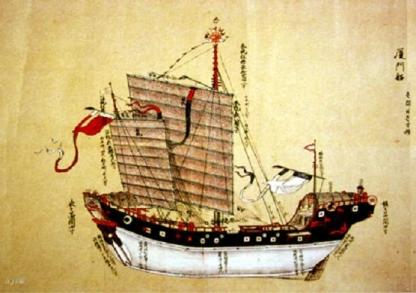 A Chinese junk during the Ming dynastyMongol raids across the Great Wall recurred in the late 1540s and early 1550s, by which time pirate raids along the southeast coast (particularly in the wealthy Jiangnan area, which was easily accessible from the sea because of its location at the mouth of the Yangtze River) had become a serious security issue as well. The Ming managed to handle this threat through a combination of military force and a relaxation of trade policies along the coast (which turned many pirates into legal traders). Henceforth, maritime trade (both within China and internationally) increased substantially during the second half of the 16th century through the easier legal access to ports along the Chinese coast, which coincided nicely with the arrival of the Spanish in these waters.
A Chinese junk during the Ming dynastyMongol raids across the Great Wall recurred in the late 1540s and early 1550s, by which time pirate raids along the southeast coast (particularly in the wealthy Jiangnan area, which was easily accessible from the sea because of its location at the mouth of the Yangtze River) had become a serious security issue as well. The Ming managed to handle this threat through a combination of military force and a relaxation of trade policies along the coast (which turned many pirates into legal traders). Henceforth, maritime trade (both within China and internationally) increased substantially during the second half of the 16th century through the easier legal access to ports along the Chinese coast, which coincided nicely with the arrival of the Spanish in these waters.
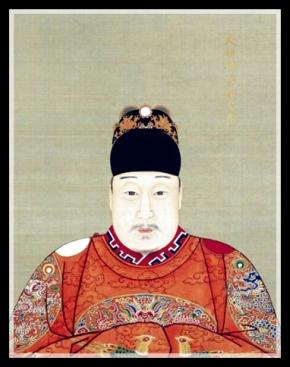 Portrait of the Wanli Emperor Zhu YijunNear the end of the 16th century, other problems began to plague the Ming dynasty during the reign of the Wanli Emperor Zhu Yijun (AD 1563 - 1620) who reigned from AD 1572 until his death in AD 1620. His advisor Zhang Juzheng (the chief Grand Secretary of the Ming state at that time) had initiated a series of well-intentioned reforms with the objective of strengthening the power of the central Ming state.
Portrait of the Wanli Emperor Zhu YijunNear the end of the 16th century, other problems began to plague the Ming dynasty during the reign of the Wanli Emperor Zhu Yijun (AD 1563 - 1620) who reigned from AD 1572 until his death in AD 1620. His advisor Zhang Juzheng (the chief Grand Secretary of the Ming state at that time) had initiated a series of well-intentioned reforms with the objective of strengthening the power of the central Ming state.
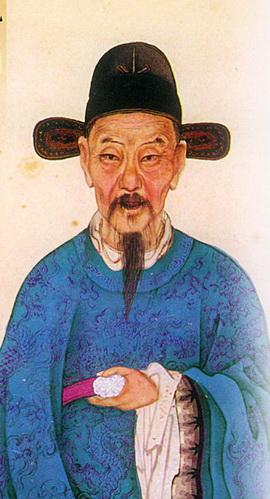 Grand Secretary Zhang JuzhengOne part of these reforms - named the "Single Whip Reforms" - changed the revenue taxation system. Until then, taxes had customarily been "paid in kind" , usually in grain (in the fall after the harvest season) or cloth (after the winter weaving in spring).
Grand Secretary Zhang JuzhengOne part of these reforms - named the "Single Whip Reforms" - changed the revenue taxation system. Until then, taxes had customarily been "paid in kind" , usually in grain (in the fall after the harvest season) or cloth (after the winter weaving in spring).
Zhang Juzheng's reforms changed the payment of taxes to a cash transaction in silver. Instead of paying different kinds of taxes in different ways (some taxes in grain, others in cloth etc.), taxable individuals had to now pay all their taxes in silver, which they obtained through the sale of their products. This new system worked well in the wealthier regions that had benefited from substantial economic growth (like the Jiangnan region and other coastal regions) and where silver was in abundant circulation (through trade with the Spanish and from the Japanese silver mines). In those regions, it made both the collection and payment of taxes much more efficient and a large part of these taxation revenues filled up the imperial treasury. In other areas where economic growth lacked behind and far less silver was in circulation, these "Single Whip Reforms" had a negative effect on economic development and began to be resented by the less wealthy population.
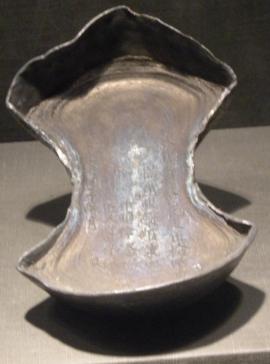 Ming dynasty silver bullion ingot found in a tombThe people there had to sell their products for copper coins (since there was not enough silver in circulation there), which was then converted at a disadvantageous exchange rate to silver. Therefore, the tax payers in these poorer regions effectively paid higher taxes after the implementation of these reforms than before. That obviously created resentment as the people there would have much preferred to continue to pay their taxes in grain or cloth or even copper.
Ming dynasty silver bullion ingot found in a tombThe people there had to sell their products for copper coins (since there was not enough silver in circulation there), which was then converted at a disadvantageous exchange rate to silver. Therefore, the tax payers in these poorer regions effectively paid higher taxes after the implementation of these reforms than before. That obviously created resentment as the people there would have much preferred to continue to pay their taxes in grain or cloth or even copper.
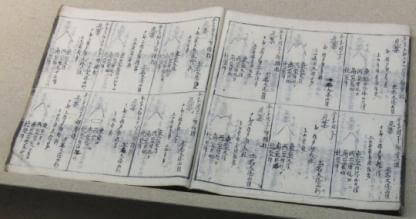 Ming dynasty land register offically compiled for taxesThe second part of the reforms that were initiated by Zhang Juzheng regarded the ownership of land. By that time, the imperial records of land ownership were largely outdated. In fact, the last comprehensive survey regarding land ownership within the Chinese empire had taken place in AD 1393 during the early years of the Ming dynasty!
Ming dynasty land register offically compiled for taxesThe second part of the reforms that were initiated by Zhang Juzheng regarded the ownership of land. By that time, the imperial records of land ownership were largely outdated. In fact, the last comprehensive survey regarding land ownership within the Chinese empire had taken place in AD 1393 during the early years of the Ming dynasty!
Zhang Juzheng tried to rectify this situation by launching a new land ownership survey. Officials were sent out all over the empire to survey land and look through existing records in order to find out how much land of which quality everyone owned. This information would then be used for determining the proper tax burden for every landowner.
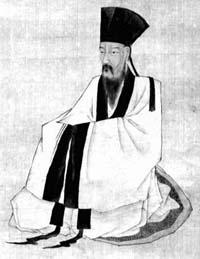 the Neo-Confucian philosopher Wang YangmingUnderstandably, this land survey was not popular among the wealthy landowners (who often belonged to the literati class). Not wanting to pay more taxes, they tried everything within their power to undermine and resist these efforts. Zhang Juzheng's unpopular land survey is a good example for the conflict of interest that the literati faced. On the one hand, they were usually employed as government officials who were paid to serve the interests of the imperial state. On the other hand, they were often land owners themselves. So, fulfilling their duties as government officials would have been in direct opposition to their own private interests as wealthy landowners. The anger of large groups among the literati regarding this land survey directed itself against Zhang Juzheng personally and led to his downfall in the early 1580s.
the Neo-Confucian philosopher Wang YangmingUnderstandably, this land survey was not popular among the wealthy landowners (who often belonged to the literati class). Not wanting to pay more taxes, they tried everything within their power to undermine and resist these efforts. Zhang Juzheng's unpopular land survey is a good example for the conflict of interest that the literati faced. On the one hand, they were usually employed as government officials who were paid to serve the interests of the imperial state. On the other hand, they were often land owners themselves. So, fulfilling their duties as government officials would have been in direct opposition to their own private interests as wealthy landowners. The anger of large groups among the literati regarding this land survey directed itself against Zhang Juzheng personally and led to his downfall in the early 1580s.
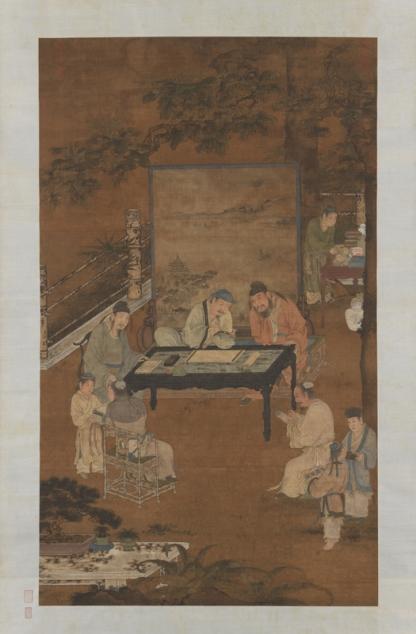 the calligraphy section out of a scroll set of four hanging scrolls by an anonymous Ming dynasty artist entitled "Elegant Pursuits of the Literati: The Eighteen Scholars"Even though the taxation reform and land survey posed some serious practical problems, the basic operations of the Ming state still continued to run smoothly. However, from the end of the 16th century onwards, there were further philosophical and political problems that incapacitated the Ming state from functioning effectively, especially in its ability to adapt to changing circumstances and newly arising problems. The government official and philosopher Wang Yangming (AD 1472 - 1529) - sometimes referred to as the last great Confucian philosopher in imperial times - had greatly influenced the philosophical and political discourse within China by highlighting certain ideas of Neo-Confucianism.
the calligraphy section out of a scroll set of four hanging scrolls by an anonymous Ming dynasty artist entitled "Elegant Pursuits of the Literati: The Eighteen Scholars"Even though the taxation reform and land survey posed some serious practical problems, the basic operations of the Ming state still continued to run smoothly. However, from the end of the 16th century onwards, there were further philosophical and political problems that incapacitated the Ming state from functioning effectively, especially in its ability to adapt to changing circumstances and newly arising problems. The government official and philosopher Wang Yangming (AD 1472 - 1529) - sometimes referred to as the last great Confucian philosopher in imperial times - had greatly influenced the philosophical and political discourse within China by highlighting certain ideas of Neo-Confucianism.
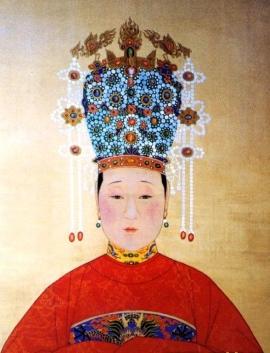 the official imperial portrait of Ming dynasty Empress Dowager XiaojingAccording to Wang Yangming's thinking, everyone had within them an "innate knowledge of the good". Whereas previously, adherents to the Confucian ideology had looked up to the literati elite as a source for moral and practical leadership, Wang Yangming's ideology encouraged everyone to look into his/her own personal conscience to find moral guidance. Not only that, his radical individualist philosophy stressed the importance of taking concrete practical action upon finding out what was morally good and bad.
the official imperial portrait of Ming dynasty Empress Dowager XiaojingAccording to Wang Yangming's thinking, everyone had within them an "innate knowledge of the good". Whereas previously, adherents to the Confucian ideology had looked up to the literati elite as a source for moral and practical leadership, Wang Yangming's ideology encouraged everyone to look into his/her own personal conscience to find moral guidance. Not only that, his radical individualist philosophy stressed the importance of taking concrete practical action upon finding out what was morally good and bad.
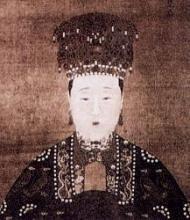 Lady Zheng, the Wanli Emperor's favourite concubineWang Yangming's philosophy found widespread acceptance among the literati and common people alike at the end of the 16th and the beginning of the 17th century. It led to the creation of popular movements among merchants, artisans, peasants etc. who felt encouraged to act upon their own moral insights and sometimes openly defied the power of local officials.
Lady Zheng, the Wanli Emperor's favourite concubineWang Yangming's philosophy found widespread acceptance among the literati and common people alike at the end of the 16th and the beginning of the 17th century. It led to the creation of popular movements among merchants, artisans, peasants etc. who felt encouraged to act upon their own moral insights and sometimes openly defied the power of local officials.
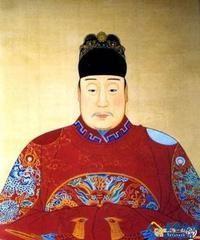 Zhu Changxun, son of the Wanli Emperor and his concubine Lady ZhengThe educated literati elites and officials were also deeply influenced in their intellectual debates by Wang Yangming's ideas and these discussions carried over into the political realm. It became nearly impossible to find a common middle ground in those political debates, since everyone was convinced of the moral purity and righteousness of their own position (thinking along the lines of: "since I have an innate knowledge of the good and my opinion is x, so your opinion y must be bad/evil") and saw the opinion of the other side as evil. Accordingly, political decision-making was greatly impeded.
Zhu Changxun, son of the Wanli Emperor and his concubine Lady ZhengThe educated literati elites and officials were also deeply influenced in their intellectual debates by Wang Yangming's ideas and these discussions carried over into the political realm. It became nearly impossible to find a common middle ground in those political debates, since everyone was convinced of the moral purity and righteousness of their own position (thinking along the lines of: "since I have an innate knowledge of the good and my opinion is x, so your opinion y must be bad/evil") and saw the opinion of the other side as evil. Accordingly, political decision-making was greatly impeded.
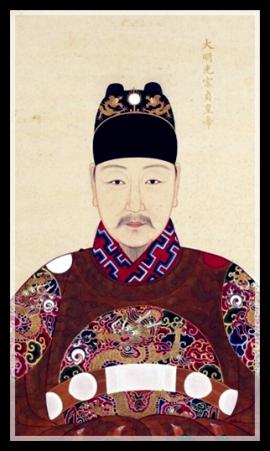 Portrait of the Taichang Emperor Zhu ChangluoAt those times of factional conflict among the literati officials, the emperor could have provided the necessary leadership. At the same time however, the Wanli Emperor Zhu Yijun withdrew from the regular administration of his empire due to a squabble with his officials regarding his reign of succession. Even though Empress Dowager Xiaojing had given him his first son Zhu Changluo in AD 1582, Zhu Yijun nevertheless wanted to replace her as empress with his new favourite concubine Lady Zheng. Furthermore, he wanted to make his third son Zhu Changxun (Lady Zheng's son) his legitimate heir, a demand his Confucian officials refused to comply with on moral grounds. In this way, the possible political leadership of the imperial court at these times of crisis was not available either.
Portrait of the Taichang Emperor Zhu ChangluoAt those times of factional conflict among the literati officials, the emperor could have provided the necessary leadership. At the same time however, the Wanli Emperor Zhu Yijun withdrew from the regular administration of his empire due to a squabble with his officials regarding his reign of succession. Even though Empress Dowager Xiaojing had given him his first son Zhu Changluo in AD 1582, Zhu Yijun nevertheless wanted to replace her as empress with his new favourite concubine Lady Zheng. Furthermore, he wanted to make his third son Zhu Changxun (Lady Zheng's son) his legitimate heir, a demand his Confucian officials refused to comply with on moral grounds. In this way, the possible political leadership of the imperial court at these times of crisis was not available either.
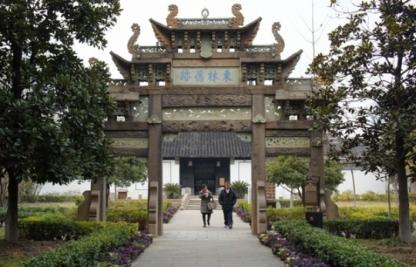 Memorial arch at the site of the former Donglin Academy in Wuxi (Jiangsu province)At the beginning of the 17th century, a new political force appeared on the scene under the guise of an academy, since outright political organizations were banned. Previously, members of the literati class had used literary societies, poetry groups and gardening clubs as places where political ideas were exchanged and political actions coordinated as well.
Memorial arch at the site of the former Donglin Academy in Wuxi (Jiangsu province)At the beginning of the 17th century, a new political force appeared on the scene under the guise of an academy, since outright political organizations were banned. Previously, members of the literati class had used literary societies, poetry groups and gardening clubs as places where political ideas were exchanged and political actions coordinated as well.
The Donglin Academy (donglin = eastern forest) in the Jiangnan area became the center for a political movement among young literati with a set of shared values. Its members helped each other to succeed within the imperial examination system and bureaucracy and openly criticised the power holding Confucian imperial officials as morally corrupt. The ultimate goal of the Donglin partisans was to replace the existing government officials and henceforth provide the moral and practical leadership of the empire themselves.
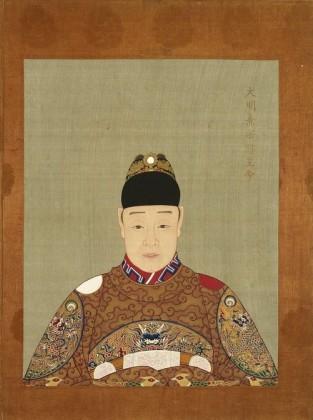 Portrait of the Tianqi Emperor Zhu YouxiaoThese aspirations were shattered after the Wanli Emperor died in AD 1620. He was succeeded by Zhu Changluo, his original heir and first son, who however died only about a month later after just having begun his reign. Zhu Changluo's eldest son Zhu Youxiao then took over the reigns of the empire and initiated a series of purges in the 1620s in which many Donglin partisans and sympathizers were executed. Zhu Youxiao was followed on the Ming throne in AD 1627 by another weak leader, the Chongzhen Emperor Zhu Youjian. During this period of weak leadership from the side of the emperor, some powerful eunuchs stepped into the void and seized some leading positions within the imperial government.
Portrait of the Tianqi Emperor Zhu YouxiaoThese aspirations were shattered after the Wanli Emperor died in AD 1620. He was succeeded by Zhu Changluo, his original heir and first son, who however died only about a month later after just having begun his reign. Zhu Changluo's eldest son Zhu Youxiao then took over the reigns of the empire and initiated a series of purges in the 1620s in which many Donglin partisans and sympathizers were executed. Zhu Youxiao was followed on the Ming throne in AD 1627 by another weak leader, the Chongzhen Emperor Zhu Youjian. During this period of weak leadership from the side of the emperor, some powerful eunuchs stepped into the void and seized some leading positions within the imperial government.
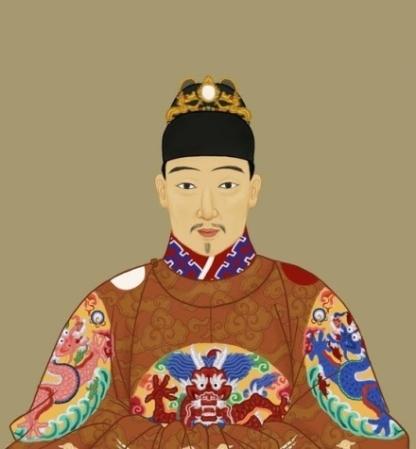 Portrait of the Chongzhen Emperor Zhu YoujianMeanwhile, the unsolved problems in society and the economy deteriorated further and further. Economically, the gap in development and wealth between the rich coastal regions and poor interior continued to grow. Particularly in the poor northwest of China, the livelihood of farmers was severely affected in a negative way by the stubborn insistence of the imperial government to pay all taxes in silver. There, more and more people were unable to pay their taxes and had some of their assets seized or even lost their land completely. Many of these dispossessed joined bandit and/or rebel groups.
Portrait of the Chongzhen Emperor Zhu YoujianMeanwhile, the unsolved problems in society and the economy deteriorated further and further. Economically, the gap in development and wealth between the rich coastal regions and poor interior continued to grow. Particularly in the poor northwest of China, the livelihood of farmers was severely affected in a negative way by the stubborn insistence of the imperial government to pay all taxes in silver. There, more and more people were unable to pay their taxes and had some of their assets seized or even lost their land completely. Many of these dispossessed joined bandit and/or rebel groups.
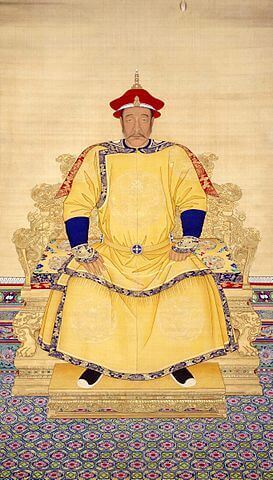 Nurhaci, who founded the Later Jin dynasty (a predecessor of the Qing dynasty)Conflicts in the richer economically developed areas were more subtle and concerned the burgeoning class of wealthy merchants. Unhappy with the fact that they were excluded from the imperial examinations and any other meaningful participation in public affairs, they began to instigate for change and openly competed with the traditional literati elite as patrons of art, builders of great libraries, charitable donors and even with their consumerist/extravagant lifestyle that was characterized by the building of opulent residences and their choice of ostentatious garments (that were traditionally worn by the literati class).
Nurhaci, who founded the Later Jin dynasty (a predecessor of the Qing dynasty)Conflicts in the richer economically developed areas were more subtle and concerned the burgeoning class of wealthy merchants. Unhappy with the fact that they were excluded from the imperial examinations and any other meaningful participation in public affairs, they began to instigate for change and openly competed with the traditional literati elite as patrons of art, builders of great libraries, charitable donors and even with their consumerist/extravagant lifestyle that was characterized by the building of opulent residences and their choice of ostentatious garments (that were traditionally worn by the literati class).
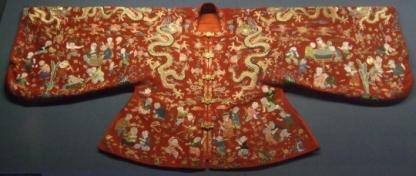 Ming dynasty garments of the wealthy classAs the Ming state became increasingly paralysed through political infighting, a new power arose in the northeast of China beyond the Great Wall. The Manchus, future conquerors of China by the middle of the 17th century, were an amalgamation of different tribes and ethnic groups that had been brought together by their founder Nurhaci (AD 1559 - 1626).
Ming dynasty garments of the wealthy classAs the Ming state became increasingly paralysed through political infighting, a new power arose in the northeast of China beyond the Great Wall. The Manchus, future conquerors of China by the middle of the 17th century, were an amalgamation of different tribes and ethnic groups that had been brought together by their founder Nurhaci (AD 1559 - 1626).
The ethnic Jurchen Nurhaci had succeeded through a combination of military conquests and political diplomacy to forge a strong bond between the Jurchen people and other tribal groups who lived in their vicinity in the northeast of China. This newly forged group of different peoples began to call itself (and to be called) the Manchus in the first quarter of the 17th century.
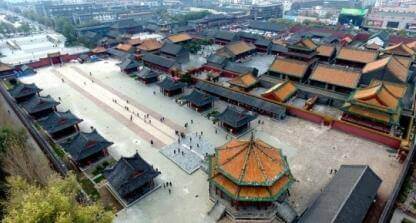 aerial view of Shenyang's Imperial PalaceIn this period, the Manchus worked on the development of their own sense of identity and internal organisation, which included the adoption of a writing system, that was based upon the writing system of the Mongols. It was used to create a written "History of the Manchu People", in which all the old legends and myths of their ancestors were immortalized. Many Manchus adopted Buddhism as their religion and the development of cultural relationships with neighbouring peoples, particularly with the Mongols, helped them to consolidate their power in their inhabited territories.
aerial view of Shenyang's Imperial PalaceIn this period, the Manchus worked on the development of their own sense of identity and internal organisation, which included the adoption of a writing system, that was based upon the writing system of the Mongols. It was used to create a written "History of the Manchu People", in which all the old legends and myths of their ancestors were immortalized. Many Manchus adopted Buddhism as their religion and the development of cultural relationships with neighbouring peoples, particularly with the Mongols, helped them to consolidate their power in their inhabited territories.
Beginning with the proclamation of a revived Jin dynasty - the Later Jin dynasty - in AD 1626, the Manchus began to signal their ambition of becoming the new rulers of the Chinese empire. The decision to copy Beijing's layout and design for their capital Mukden (nowadays Shenyang in Liaoning province) was a further signal for their imperial ambitions. The former imperial palace of the Manchus in Shenyang (a.k.a. Mukden Palace) is now a UNESCO World Heritage site and a popular tourist attraction.
Shenyang Imperial Palace
As one of only two imperial palaces in China, the Shenyang Imperial Palace was where the first three emperors of the Qing dynasty lived between AD 1625 and 1644. Since this former Qing capital was still named Mukden back then, the palace is also known and referred to as the Mukden Palace. It now serves as the Shenyang Palace Museum. This UNESCO world heritage site at the center of Shenyang (Liaoning province) is about 1/12th the size of Beijing's Forbidden City.
Click here to learn more!Opening Hours
April 10th - October 10th: 8.30am - 5.30pm
October 11th - April 9th: 9am - 4.30pm
Closed on Monday afternoons except during holidays and in July & August
Entrance Ticket Prices
60 yuan
ticket sales stop 45 min before closing time
In AD 1635, the Manchu language (that is based upon the Jurchen language) became the official language at their court in Mukden. One year later in AD 1636, the official name of their dynasty was changed from Jin (jin = gold), which was also the surname of the most influential Manchu family at that time, to Qing (qing = pure). By presenting themselves as the pure element within society, they further signalled their intention to sweep aside the (by then) decadent Ming dynasty on their way to a morally purified China.
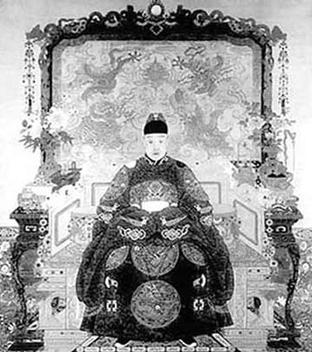 the eunuch official Wei ZhongxianBy the end of the 1630s and during the early 1640s, the Manchus increased their military campaigns against the Ming and their successful siege in AD 1641 of the Ming garrison at Jinzhou, outside the Great Wall, was a first major victory, also due to the fact that several Ming generals defected to their side afterwards. In early AD 1644, the Manchus effectively controlled the entire northeast of the country, including the Chinese settlements in Southern Manchuria (north of the Great Wall), right down to the Great Wall that still separated them from the agricultural heartland of the Ming empire.
the eunuch official Wei ZhongxianBy the end of the 1630s and during the early 1640s, the Manchus increased their military campaigns against the Ming and their successful siege in AD 1641 of the Ming garrison at Jinzhou, outside the Great Wall, was a first major victory, also due to the fact that several Ming generals defected to their side afterwards. In early AD 1644, the Manchus effectively controlled the entire northeast of the country, including the Chinese settlements in Southern Manchuria (north of the Great Wall), right down to the Great Wall that still separated them from the agricultural heartland of the Ming empire.
Meanwhile, the Ming empire had continued to weaken from within. Even though the factional conflicts at court of the 1620s (that had cost many lives) had come to an end in AD 1627, when the Chongzhen Emperor ascended the throne and broke the stranglehold on power of the powerful eunuch Wei Zhongxian, the Ming never regained their former vigour. The subsequent reforms by the emperor were too little too late to reverse the downward spiral of the Ming empire. Besides the political uncertainties, the empire suffered from growing financial problems due to the decline in tax revenue.
The flow of silver into China had begun to decrease substantially (particularly from Japan, where export controls were put in place). The Ming rulers stubbornly insisted upon the payment of taxes in silver, of which there was less and less in circulation.
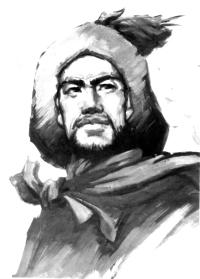 drawing of the rebel leader Li ZichengAs previously mentioned, large numbers of farmers defaulted on their tax payments (particularly in the poorer northwestern and southwestern regions) and lost their assets and land. The growing landless farming population in these areas swelled the ranks of rebel and bandit forces, which increased their raids of small towns, government granaries and treasuries. The soldiers that were sent there by the Ming government to quell the unrest ended up joining the bandit and rebel forces in large numbers, since they often hadn't been paid their salaries by the government.
drawing of the rebel leader Li ZichengAs previously mentioned, large numbers of farmers defaulted on their tax payments (particularly in the poorer northwestern and southwestern regions) and lost their assets and land. The growing landless farming population in these areas swelled the ranks of rebel and bandit forces, which increased their raids of small towns, government granaries and treasuries. The soldiers that were sent there by the Ming government to quell the unrest ended up joining the bandit and rebel forces in large numbers, since they often hadn't been paid their salaries by the government.
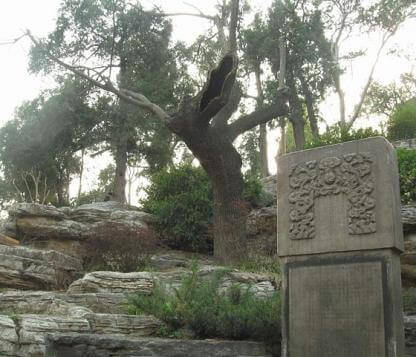 the supposed tree in the Jingshan Park north of the Forbidden City from which the Chongzhen Emperor hanged himselfLi Zicheng (AD 1606 - 1645) emerged as the main leader of these rebel movements in the northwest of China at the end of the 1630s and the beginning of the 1640s. The rebel army that he assembled and led didn't pursue any political or religious goals, but simply sought to improve the livelihoods of its constituents (mostly poor and disowned farmers) and they saw the overthrow of the Ming dynasty as the best way to ensure that.
the supposed tree in the Jingshan Park north of the Forbidden City from which the Chongzhen Emperor hanged himselfLi Zicheng (AD 1606 - 1645) emerged as the main leader of these rebel movements in the northwest of China at the end of the 1630s and the beginning of the 1640s. The rebel army that he assembled and led didn't pursue any political or religious goals, but simply sought to improve the livelihoods of its constituents (mostly poor and disowned farmers) and they saw the overthrow of the Ming dynasty as the best way to ensure that.
In the early 1640s, Li Zicheng led his army north from battle to battle through northern Shaanxi. In the spring of AD 1644, his rebel army marched towards the imperial capital of Beijing from the northwest, which they then attacked and seized in April of the same year.
Possibly out of hopelessness and despair on the day after that attack, the Chongzhen Emperor walked up the artificial hill (now a tourist attraction as part of the public Jingshan Park) just north of the Forbidden City. There, he then cut his finger and wrote the two Chinese characters that signified "son of heaven" in blood on a piece of silk before hanging himself from a tree. That episode effectively ended the Ming dynasty, even though Ming loyalists managed to hold out for another 40 years in certain areas!
Jingshan Park
Jingshan Park is a former imperial garden that is located on the artificially-created Jingshan Hill just north of the Forbidden City at the center of Beijing. Emperors performed their ancestor worship there and enjoyed the views and scenery. During the late Ming dynasty, one emperor hanged himself from a tree at this park. Nowadays, most visitors come to Jingshan Park to enjoy the spectacular views of the surrounding city from the hill's five peaks.
Click here to learn more!Opening Hours
April - October: 6am - 9pm
November - March: 6.30am - 8pm
Tickets sold until 30 min before closing time
Entrance Ticket Prices
2 yuan
fee for exhibitions in the park not included
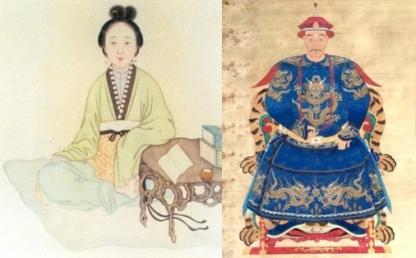 Left: concubine Chen Yuanyuan Right: General Wu SanguiAfter bringing Beijing under his control, Li Zicheng proclaimed the new short-lived Shun dynasty with himself as the new emperor. He then tried to build his new government by calling on former Ming officials (who hadn't fled Beijing) to present themselves at his new court. However, most court officials and imperial princes had already fled south to their secondary political center of Nanjing.
Left: concubine Chen Yuanyuan Right: General Wu SanguiAfter bringing Beijing under his control, Li Zicheng proclaimed the new short-lived Shun dynasty with himself as the new emperor. He then tried to build his new government by calling on former Ming officials (who hadn't fled Beijing) to present themselves at his new court. However, most court officials and imperial princes had already fled south to their secondary political center of Nanjing.
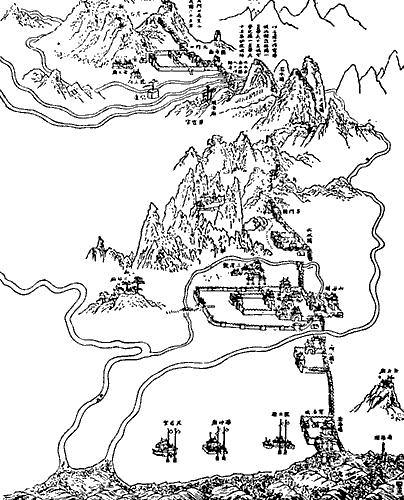 old illustration of a map of ShanhaiguanUpon hearing of Li Zicheng's conquest of Beijing and the death of the Ming emperor, a Ming general at the far eastern end of the Great Wall made a fateful decision.
old illustration of a map of ShanhaiguanUpon hearing of Li Zicheng's conquest of Beijing and the death of the Ming emperor, a Ming general at the far eastern end of the Great Wall made a fateful decision.
Wu Sangui (AD 1612 - 1678) was the able Ming general who was in charge of the important fortress near the eastern end of the Great Wall at Shanhaiguan (Shanhaiguan = pass between mountains and the sea). Repeatedly, his forces had prevented the Manchu forces from entering China through the strategic Shanhai mountain pass.
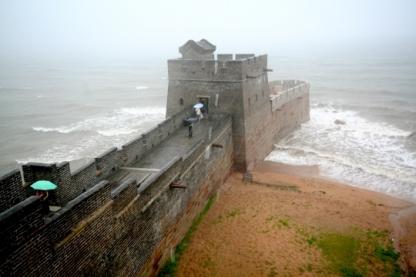 "Old Dragon's Head" - the eastern end of the Great Wall at ShanhaiguanWorried about his mistress Chen Yuanyuan (AD 1624 – 1681) who had fallen into the hands of Li Zicheng in Beijing and also about an approaching contingent of Li Zicheng's army, he negotiated an agreement with the leaders of the Manchus, that allowed them to bring their army through the Shanhai Pass into China.
"Old Dragon's Head" - the eastern end of the Great Wall at ShanhaiguanWorried about his mistress Chen Yuanyuan (AD 1624 – 1681) who had fallen into the hands of Li Zicheng in Beijing and also about an approaching contingent of Li Zicheng's army, he negotiated an agreement with the leaders of the Manchus, that allowed them to bring their army through the Shanhai Pass into China.
The city and surroundings of Shanhaiguan are nowadays very popular with tourists due to a large number of visitable sites. Especially the Great Wall sites like "Old Dragon's Head" where the Great Wall reaches out into the sea (see picture above) should not be missed.
The Manchu and Ming army proceeded to drive Li Zicheng's army out of Beijing. The Manchus then seized Beijing for themselves and set about ruling their newly conquered lands under the name of the Qing dynasty (AD 1644 - 1912).
Shanhaiguan Great Wall
The Great Wall at Shanhaiguan once played a vital role in protecting China from attacks from the north. During imperial times, the Shanhai Pass at Shanhaiguan was protected by the Jiaoshan Great Wall, the First Pass Under Heaven and Old Dragon's Head (Laolongtou). Shanhaiguan also played a major role in the fall of the Ming dynasty to the Manchus. The Shanhaiguan Great Wall Museum is the best place to get a good overview of the various fortifications that are a part of the Great Wall system in the Shanhaiguan area.
Click here to learn more!Opening Hours
Shanhaiguan Great Wall Museum: 8am - 5pm
Jiaoshan Great Wall: 5am - 6.30pm
First Pass Under Heaven & Old Dragon's Head: 7am - 6pm (May - October) 7.30am - 5pm (November - April)
Entrance Ticket Prices
Shanhaiguan Great Wall Museum: Free
First Pass Under Heaven: 40 yuan (May - October) 15 yuan (November - April)
Old Dragon's Head: 50 yuan (May - October) 20 yuan (November - April)
Jiaoshan Great Wall: 30 yuan (April - November) 10 yuan (December - March)
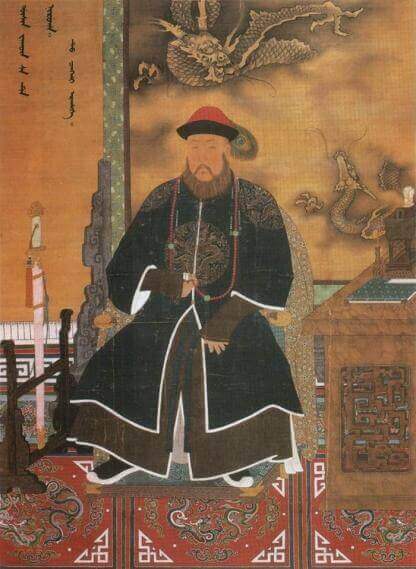 Regent Dorgon a.k.a. Prince Rui of the Qing dynastyThe leadership of the Qing dynasty was mostly in the hands of the Regent Dorgon at the time of the conquest of China, since the reigning Shunzhi emperor of the Qing was still only a child.
Regent Dorgon a.k.a. Prince Rui of the Qing dynastyThe leadership of the Qing dynasty was mostly in the hands of the Regent Dorgon at the time of the conquest of China, since the reigning Shunzhi emperor of the Qing was still only a child.
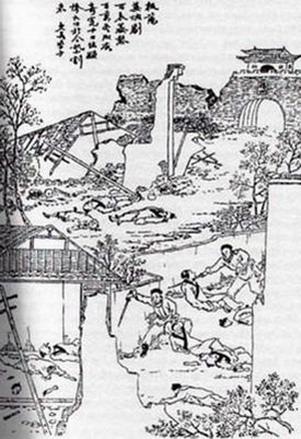 late Qing dynasty depiction of the massacre of YangzhouWu Sangui continued to help defeat the remaining Ming loyalist forces and was later handsomely rewarded by his Manchu allies with his own virtual kingdom in southern Yunnan.
late Qing dynasty depiction of the massacre of YangzhouWu Sangui continued to help defeat the remaining Ming loyalist forces and was later handsomely rewarded by his Manchu allies with his own virtual kingdom in southern Yunnan.
During the next two years from AD 1644 - 1646, the Manchus continued their military conquests in their efforts to bring the rest of China under their control. In this endeavour, they encountered heroic resistance in the wealthy and culturally sophisticated Jiangnan area (popular residence of the literati class) near the mouth of the Yangtze River.
Especially Yangzhou at the northern side of the Yangtze River and along the Grand Canal - a city famous for its luxurious lifestyle and resident painters and poets - resisted the Manchu siege fiercely in AD 1645. After finally conquering Yangzhou, the Manchus took bloody revenge by looting and killing any Chinese within sight for the next ten days!
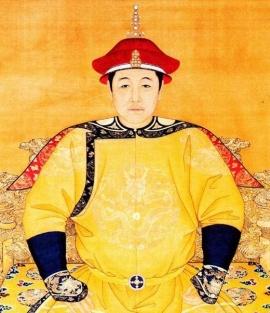 the Shunzhi Emperor of the Qing dynastyThis Massacre of Yangzhou signalled to the remaining cities under Ming control to better think twice before refusing the Manchu offer of an amiable surrender. For the Chinese, it became a symbol for the barbarism of the Manchu conquerors and the heroism of the Chinese resistance.
the Shunzhi Emperor of the Qing dynastyThis Massacre of Yangzhou signalled to the remaining cities under Ming control to better think twice before refusing the Manchu offer of an amiable surrender. For the Chinese, it became a symbol for the barbarism of the Manchu conquerors and the heroism of the Chinese resistance.
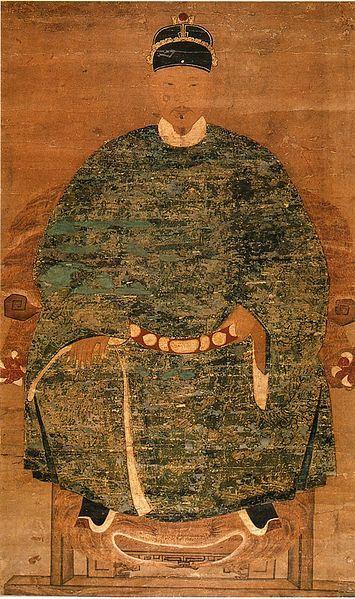 Zhu Youlang, the Yongli Emperor of the Southern Ming dynasty (a.k.a. the Prince of Gui)After fleeing Beijing, the remaining Ming court settled in Nanjing. That event marks the beginning of the Southern Ming dynasty which continued to resist the Qing invaders for quite some time. The Southern Ming named a series of princes as successive emperors, who all ended up being captured and killed (or committed suicide). When the Manchus arrived to besiege Nanjing, the court had to flee again, this time to the far southwest of the country.
Zhu Youlang, the Yongli Emperor of the Southern Ming dynasty (a.k.a. the Prince of Gui)After fleeing Beijing, the remaining Ming court settled in Nanjing. That event marks the beginning of the Southern Ming dynasty which continued to resist the Qing invaders for quite some time. The Southern Ming named a series of princes as successive emperors, who all ended up being captured and killed (or committed suicide). When the Manchus arrived to besiege Nanjing, the court had to flee again, this time to the far southwest of the country.
By the end of the 1640s, most resistance against Manchu rule had been quashed. Zhu Youlang (a.k.a. the Prince of Gui and the Yongli Emperor of the Southern Ming dynasty), the last legitimate claimant to the Ming throne, fled to the area that is now Burma where he lived in exile until AD 1662.
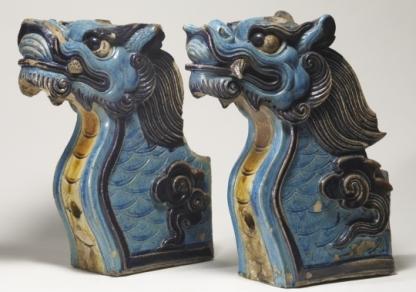 ceramic-glazed temple beam ends in the shape of dragons from the 16th centuryBy that time, the Manchus had managed to get the entire southwest of China under their control as well. They then negotiated an agreement with the Burmese rulers that saw Zhu Youlang and his family turned over to them in January of AD 1662. These Manchu forces were led by none other than Wu Sangui who personally strangled Zhu Youlang!
ceramic-glazed temple beam ends in the shape of dragons from the 16th centuryBy that time, the Manchus had managed to get the entire southwest of China under their control as well. They then negotiated an agreement with the Burmese rulers that saw Zhu Youlang and his family turned over to them in January of AD 1662. These Manchu forces were led by none other than Wu Sangui who personally strangled Zhu Youlang!
Without ever mounting a serious attempt to reestablish themselves on the mainland, the last remaining Ming loyalists held out on the island of Taiwan (then partially occupied by the Dutch and Portuguese as well as various pirate groups) until AD 1683, when they were finally suppressed there as well.
Chinese History Digest's summary of China's history continues in the next section with a prolonged period of peace and prosperity under the Qing dynasty.
